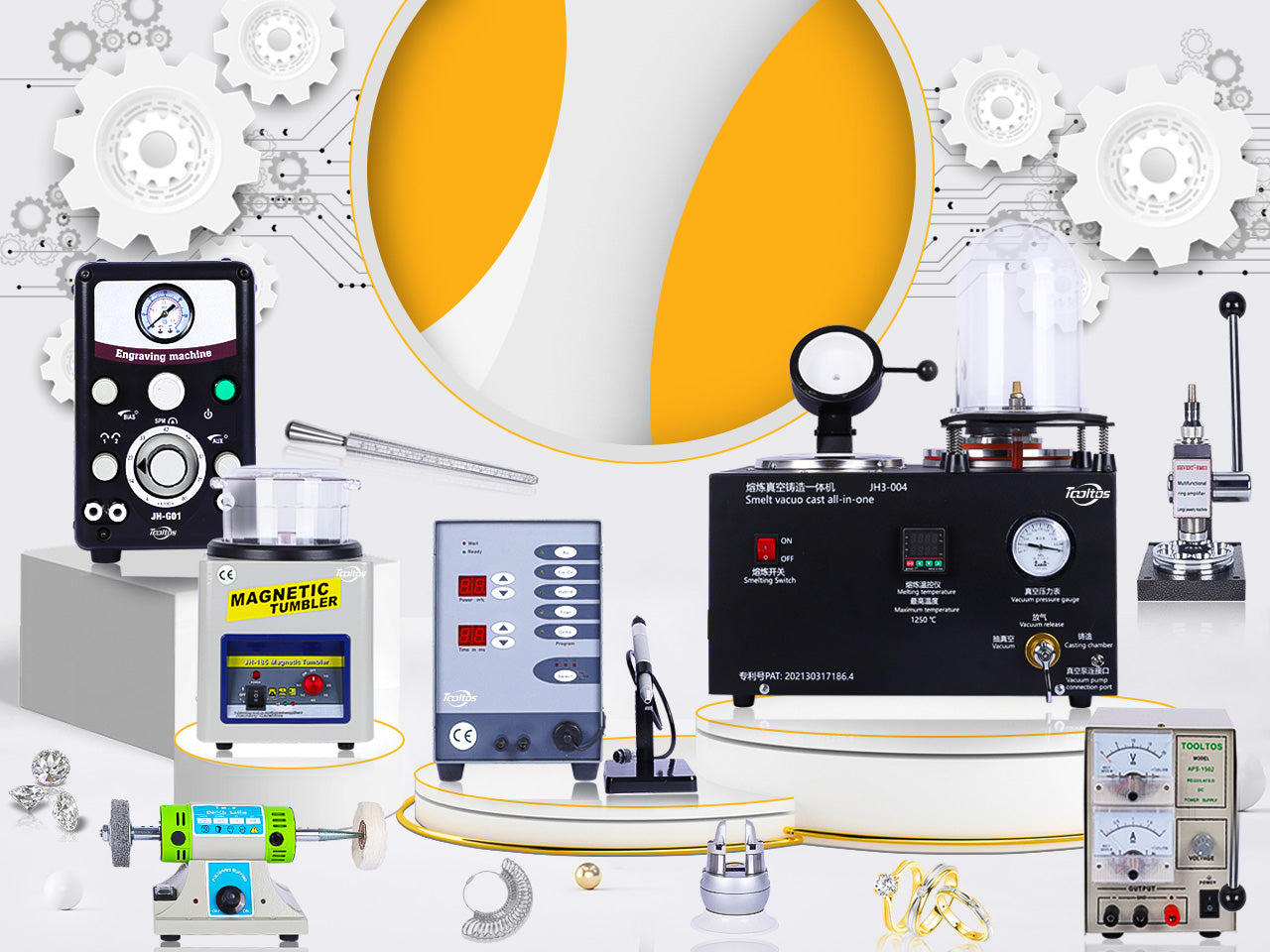Sie sind neu im Bereich Schmuckpolieren und möchten mehr über die im Schmuckherstellungsprozess verwendeten Fachbegriffe erfahren?
Nutzen Sie unser Polierglossar, um sich über alle Werkzeuge und Begriffe im Zusammenhang mit dem Polierprozess zu informieren.
Polieren
Beim Polieren von Schmuck werden kleine Schmutzmengen von der Metalloberfläche entfernt. Zurück bleibt eine glatte Oberfläche, die anschließend für das Polieren vorbereitet wird.
Schwabbeln und Polieren
Polieren und Schleifen sind zwei Prozesse, die Schmuckstücken ihren endgültigen Glanz verleihen. Obwohl sie oft zusammen verwendet werden, handelt es sich um zwei verschiedene Prozesse.
Die verschiedenen Phasen des Polierens umfassen
Vorpolieren – Erstes Glätten und Polieren mit einer sehr groben Politur. Beim Polieren handelt es sich um einen Schleifvorgang, bei dem nur eine kleine Menge der Oberfläche abgetragen wird. Dabei werden kleine Kratzer entfernt, die durch das Schleifen entstanden sind, und die Oberfläche wird geglättet, es entsteht jedoch keine glänzende Politur.
Endpolieren – Der endgültige Hochglanz wird durch Polieren erreicht. Beim Polieren wird eine härtere Verbindung wie Polierpaste verwendet. Bei der Verwendung von Polierpaste erfolgt keine oder nur eine geringfügige Schneidwirkung; das Metall wird poliert, wobei die Oberfläche bewegt wird, um die feinen Kratzer zu glätten, die durch das Polieren entstanden sind.
Satin-Finish – Eine weniger glänzende Oberfläche mit einer weicheren Textur. Diese werden trocken verwendet und enthalten keine Politur.
Poliermotor
Poliermotoren ermöglichen Hochgeschwindigkeitspolieren und werden in Verbindung mit Polierscheiben und Polituren verwendet. Poliermotoren sind in verschiedenen Ausführungen (z. B. hängende Motoren mit flexibler Welle und Poliermotoren ) mit Drehzahlen von 5.000 U/min bis 18.000 U/min erhältlich.
Beim Einsatz des Poliermotors empfiehlt es sich, direkt unter der Mitte der Polierscheibe zu arbeiten. Platzieren Sie den Gegenstand niemals horizontal darüber oder darunter, da die Polierscheibe Ihnen sonst den Gegenstand aus der Hand reißt. Es sollte ein gewisser Druck auf die Polierscheibe ausgeübt werden, damit Sie die Schneidwirkung spüren, wenden Sie jedoch nicht zu viel Kraft an, da dies zu einer Verlangsamung des Motors führen würde, da zu viel Druck weder zu einem besseren Finish noch zu einer schnelleren Poliergeschwindigkeit führt, aber auch zu wenig Druck ist wirkungslos; versuchen Sie, einen geeigneten Zwischenwert zu finden (was mit etwas Übung einfacher wird).
Polier- und Schwabbelscheiben
Eine Polierscheibe ist ein scheibenähnlicher Zusatz, der zum Polieren von Schmuck verwendet und an einen Motor mit biegsamer Welle oder an einen Poliermotor angeschlossen wird.
Die meisten Polierscheiben haben einen Durchmesser zwischen 2 und 6 Zoll. Es kann überwältigend sein, sich über alle verschiedenen Arten von Polierscheiben zu informieren – die folgende Liste ist ein guter Ausgangspunkt.
Zu den Polierradtypen gehören:
Genähte Polierscheiben: Je mehr Nähte, desto steifer sind die Polierscheiben. Genähte Polierscheiben werden normalerweise mit einer Schleifpaste wie Tripoli in der Vorpolierphase verwendet.
Lose Polierscheiben: Lose Polierscheiben sind durch mehrere Materialsegmente mit einer einzigen Nahtreihe oder ohne Naht in der Mitte gekennzeichnet. Sie werden am häufigsten zum abschließenden Polieren mit Poliermittel verwendet. Sie weiten sich auf und decken eine große Bandbreite von Bereichen ab, sodass sie an schwer erreichbaren Stellen verwendet werden können und eine glatte polierte Oberfläche erzeugen.
Diagonale Polierscheiben: Diagonale Polierscheiben verfügen über eine ausgezeichnete Schnittkraft und Flexibilität und werden typischerweise für komplizierte Arbeiten verwendet, die unterschiedliche Schneid- und Endbearbeitungsgrade erfordern.
Sisal-Polierscheiben: Normalerweise aus robustem Stoff hergestellt und zum aggressiven Schneiden und Polieren verwendet, am häufigsten bei Edelstahl.
Polierscheiben aus Hartfilz: Ideal für flache Oberflächen und scharfe Kanten, da sie glatte Linien beibehalten. Bei der Verwendung für Schmuckzwecke ist jedoch Vorsicht geboten, da diese Linien oder Ringe auf den Stücken hinterlassen können.
Saitenpolierscheiben: Weiche Polierscheiben für Edelmetalle oder Kunststoffe
Zu den Materialien für Schwabbel- und Polierscheiben gehören:
- Baumwolle
- Kattun
- Gefühlt
- Wolle
- Wildleder
Poliermittel
Poliermittel sind Fette, Wachse oder Öle, die abrasiven Eigenschaften haben und Poliermopps zugesetzt werden. Normalerweise werden sie in kleinen Riegeln verkauft und in Verbindung mit Poliermaschinen und -mopps verwendet, um Metalle zu glätten und zu polieren. Die Begriffe Poliermittel und Polierpaste werden normalerweise synonym verwendet. Juwelierpoliermittel ist eines der besten Poliermittel und hilft dabei, den höchsten Glanz des Materials, mit dem Sie arbeiten, hervorzubringen.
Tipps zur Verwendung von Poliermitteln
Tragen Sie nicht zu viel Politur auf die Polierscheibe auf. Es wird empfohlen, Politur aufzutragen, wenn die Ergebnisse darauf hinweisen, dass dies erforderlich ist. Bewegen Sie die Polierscheibe gleichmäßig, um ein gleichmäßiges Finish zu erzielen. Wenn Sie sie zu lange in einer Position belassen, können Details verloren gehen und die Form des Werkstücks verändert werden. Bewegen Sie das Werkstück in alle möglichen Richtungen und Positionen, sodass die Polierscheibe alle Bereiche berührt. Dieses Kreuzpolieren führt auch zu einem glänzenderen Werkstück. Wenn Lötstellen poliert werden müssen, führen Sie die Polierscheibe durch die Lötstellen und nicht in Kontakt mit ihnen, damit sie nicht abgeschliffen werden.
Obwohl es anfangs schwierig sein kann, können Sie die Polierbegriffe leicht verstehen und in Ihren kreativen Prozess integrieren, um das Handwerk besser zu verstehen. Viel Spaß beim Polieren!


0 Kommentare